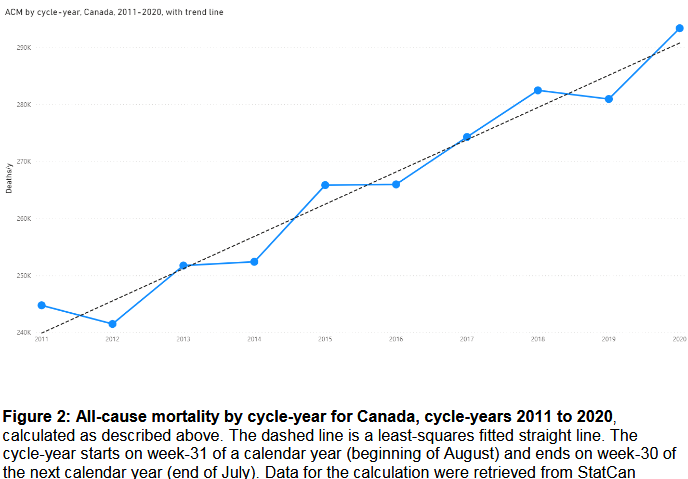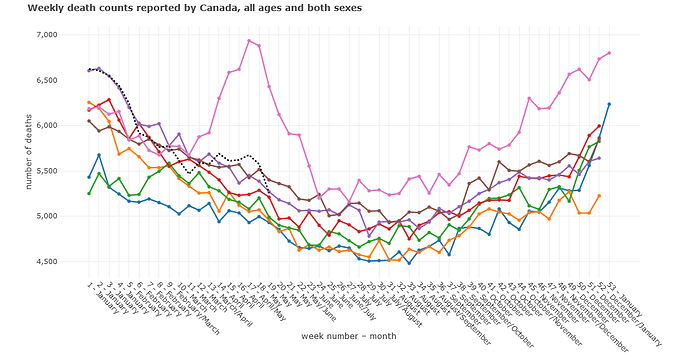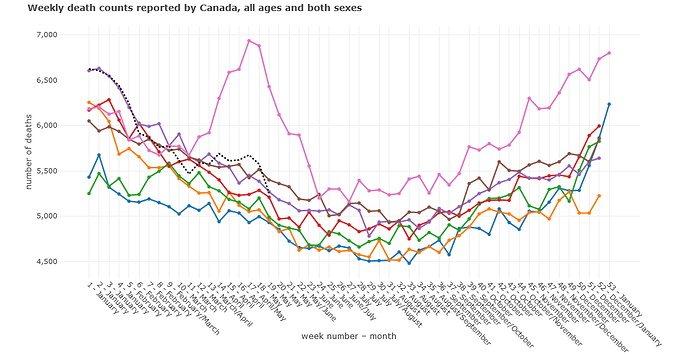@Everyman and TWIMC 
Rancourt (continued)
The pdf link to the paper is the easiest to navigate (and also allows you to paste text if you wish to): https://denisrancourt.ca/uploads_entries/1628290219153_Canada%20ACM%20into%202021%20-%20article----6dr_3.pdf
There’s not much stats at all other than the calculation of a trend, which can be more accurate than visual judgement.
ACM/w=all cause mortality by week. I think this focus is a good move, it gets us away from covid-this and covid-that, and also allows consideration of recent years individually rather than a crude average.
I think the main detail starts around PP 18-19. I’ve moved the graphs to amongst the accompanying text. I hope this slight rearrangement will be easier to read than the corresponding part of the paper.
My comments are in curly brackets {}.
Over to Rancourt:
The Canada ACM/w feature “S” (Figure 4) is anomalous because its mean baseline
magnitude (5.25K deaths/w) is anomalously larger than the summer-2019 mean
baseline value (5.05K deaths/w), and significantly larger than the magnitude predicted
by the linear summer baseline trend values for the prior years, as can be ascertained
from Figure 1.
{Okay - it is larger than previous summers even accounting for the clear upward trend in Figure 1}

{Having established an anomaly, he examines it by age}
This means that some net 200 excess deaths per week were occurring in Canada in the
summer of 2020, in a season in which VRDs are not active. Below, we show that the
main contributor to these excess summer deaths was deaths of young (0-44 years)
males , an age where COVID-19 virtually does not cause deaths (Levin et al., 2020),
occurring predominantly in Alberta, Ontario and British Columbia. Whereas, the
opposite occurs in Canada for the 85+ years age group: The summer-2020 mean
baseline magnitude (ACM/w) is significantly smaller than the 2010-2019 trend value for
this age group (Figure 6a).
{Yes, Figure 6a shows that this last statement is true}
{Jump to the 85+ age group 
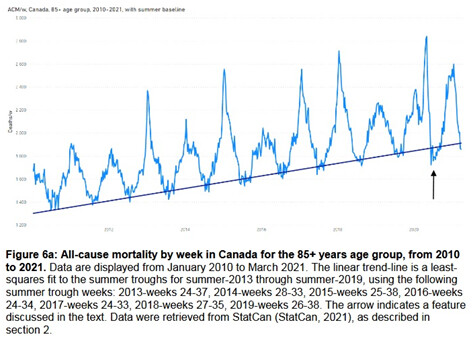
Couldn’t this point about the lower than expected number of deaths in the 85+ age group in the summer just be that covid killed people from this group during the peak, thereby removing people in this age group who without covid would have died later, in the summer?
Maybe the point is just that the aforementioned summer rise (compared to the trend of previous years) could not be explained by covid deaths as these were predominantly in the 85+ age group in which deaths had fallen.
Except…that on P28 he asks specifically: "As such, the “S”-feature in the ACM/w of the 85+ years age group (Figure 6a) is equally anomalous. Why would 85+ year olds in Canada become relatively impervious to dying in the summer of 2020, in mid pandemic, between the presumed first and second waves of death? "
Has he considered the obvious possibility mentioned above, viz. that some had already died? He says next:
“Our interpretation is: The deaths of many 85+ year olds were artificially accelerated, at a time when seasonal VRD transmission is low, so that their deaths were not spread out into the following summer and fall, as would normally be the case.”
This is a little ambiguous. Does he just mean the big covid peak accelerated the 85+ deaths in the spring? That is the default explanation. Does he mean something darker - viz, the spring ‘acceleration’ was NOT due to seasonal VRD transmission? That’s possible but I don’t see how it would follow from the graph - the rise and fall in 85+ deaths might be clear, but does the explanation not lie outside the graphs?
Pending the penny dropping in my head perhaps, I think he’s on stronger ground with the 0-44 age group.}
{The 0-44 age group}
“Another large anomaly, which should be considered a national public health catastrophe of historic proportion but is virtually absent from the media and government-official pronouncements, is shown in Figure 6d, for the 0-44 years age group. Here, we see a significant increase in deaths, from a pre-COVID-period plateau value of approximately 260 deaths/w to a summer-2020 value of approximately 320 death/w, lasting at least 28 weeks, into the start of December 2020. The peak corresponds to approximately 2,000 excess deaths in this 0-44 years age group in Canada, following the WHO pronouncement of a pandemic”
(0-44 age group)
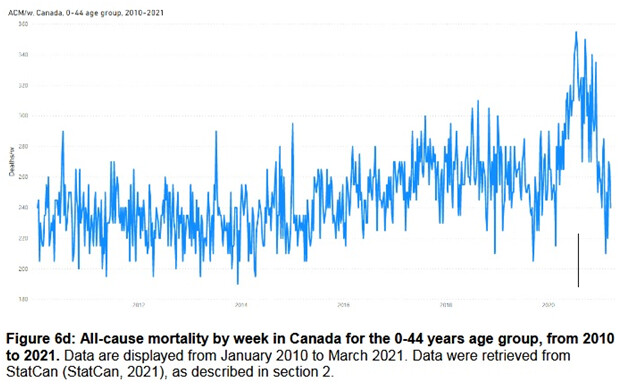
{The line I’ve added to Figure 6d is to mark the same position of the arrow as in Figure 6a, which there referred to the summer period. Rancourt refers to the average as 320 deaths per week. This is probably right - from the vertical scale the peaks read as higher than this, but don’t forget the troughs (due to this being weekly data) contribute to that average too.
He says the trend for that period is 260. We have to take this on trust (good luck in verifying this from the graph, where only alternate years are marked) but assuming this is correct, it does look like there are an excess 60 x 28 deaths, though 1680 is a better description than 2000.
He says there is a similar increase in the 45-64 age group (EDIT: albeit a smaller one). I’m prepared to take his word for that - if so it supports the contention.
This is interesting - what caused those deaths in younger males? But first the question has to be addressed whether the increase is real or just random. He does that by examining the increase further, by gender and then by province.
I’ve only glanced ahead to the gender part but I think the gist is that the increase in the 2020 death summer rates is actually down to male deaths. This strongly suggests that the increase isn’t a statistical blip, therefore requires explanation.
Cheers
